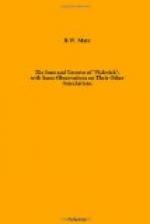During their stay at Manor Farm, Dingley Dell, the Pickwickians visited Muggleton to witness the cricket match between Dingley Dell and all Muggleton. “Everybody whose genius has a topographical bent,” says Dickens, “knows perfectly well that Muggleton is a corporate town, with a mayor, burgesses and freeman,” but so far no topographer has discovered which corporate town it was. Some say Maidstone, others Town Malling. Until that vexed question has been settled, however, the identification of the “large inn with a sign-post in front, displaying an object very common in art, but very rarely met with in nature—to wit, a Blue Lion with three legs in the air, balancing himself on the extreme point of the centre claw of his fourth foot,” cannot definitely be verified. The same remark applies to the Crown Inn, where Jingle stopped on the same occasion.
[illustration: The Swan Inn, Town Malling. Drawn by C. G. Harper]
At Maidstone there is a “White Lion,” and at Town Malling there is the “Swan.” Which of these is the original of the inn where Mr. Wardle hired a chaise and four to pursue Jingle and Miss Rachael, and on whose steps, the following Christmas, the Pickwickians, on their second visit to Dingley Dell, were deposited “high and dry, safe and sound, hale and hearty,” by the Muggleton Telegraph, when they discovered the Fat Boy just aroused from a sleep in front of the tap-room fire, must be left to the choice of the reader.
CHAPTER IV THE “WHITE HART,” BOROUGH
The pursuit of Jingle and Miss Wardle by the lady’s father and Mr. Pickwick, culminates in the “White Hart,” which, in days gone by, was one of the most famous of the many famous inns that then stood in the borough of Southwark. Long before Dickens began to write, the “White Hart” was the centre of the coaching activity of the metropolis south of the Thames, and .was one of the oldest inns in the country.
Travellers from the Continent and the southern and eastern counties of England to London made it their halting-place, whilst from a business standpoint it had scarcely a rival. Coaches laden with passengers and wagons full of articles of commerce made the courtyard of the inn always a bustling and busy corner of a hustling and busy neighbourhood. In the coaching era, therefore, the “White Hart” was a household word to travellers and business men. Dickens, with his magic pen and inventive genius, made it a household word to the inhabitants of the whole globe, who never had occasion to visit it either for business or pleasure.
Its history goes back many centuries: as far back as 1400, and possibly earlier than that. Its sign was taken from the badge of Richard II, who adopted the emblem of the “White Hart” from the crest of his mother, Joanna of Kent. A fine old inn of the highest type, the “White Hart” no doubt was the resort of the most prominent nobles and retainers of the time, public men of the period and ambassadors of commerce. It is not surprising, therefore, that it figures in English history generally, and was particularly mentioned by Shakespeare. It certainly was the centre of many a stirring scene, and events of feasting and jollity, besides being a place where great trade was transacted.




